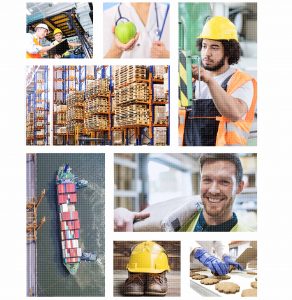Lean Manufacturing: For Customer Satisfaction and a Healthy Bottom Line
Lean Manufacturing techniques can be applied to small, medium and large businesses and have been proven to boost profitability and customer satisfaction.
Everything within the Lean manufacturing model is aimed towards maintaining focus on the two key metrics of profitability and customer satisfaction in order to remain relevant and competitive.
What exactly is ‘Lean’? We can look at the general accepted Lean manufacturing definition for some clarity on the philosophy and the process behind it:
Lean manufacturing or Lean production (often simply ‘Lean’) is a systematic method for the elimination of waste within a manufacturing system. Lean is centered on making obvious what adds value by reducing everything else.
Each facility and organisation will be different. However, adopting Lean manufacturing and working some effective Lean manufacturing courses company-wide into general operations will positively affect any given workforce with:
- Improved profitability: Lean manufacturing makes it more possible for companies to save money of labour hours, resources and wasted stock
- More efficient workforce: With a set of standard procedures, personnel can focus on what matters as opposed to activities that waste time such as looking for the right tool
- Better service: In a more streamlined workspace, workers can direct their attention to their customers as opposed to fixing broken processes
- Safer workplace: In a cleaner, safer work environment, workers are less at risk, more happy and therefore more productive
This division between what is waste and what is valuable is one of the first key points to get clear when we are talking about customer satisfaction and profitability. Based on the concept of Continuous Improvement, the process Lead thinking employs to simplify this segmentation process is one of constant searching for better ways to identify, analyse and resolve the issues around the existence of waste in the workplace.
Step 1 in Lean Manufacturing: Identifying Waste
What can be considered waste? In ‘Lean’, waste can take many forms and according to the philosophy of Continuous Improvement, waste always exists. To be truly Lean, the pursuit to reduce waste is a constant and ongoing one. While waste can appear in many forms, there are a few clearly defined types of waste that are considered to be the major issues in the way of achieving Lean manufacturing:
- Defects – Defects that result in rework or scrap can be a major cost to organisations
- Overproduction – Production that is made before it is needed or more products are made than required
- Waiting time – Time not used effectively is a waste. Idle time is often the result of poor planning or poor resource utilisation
- Not Utilising Employees – Not utilising people’s knowledge, skills and talent
- Transportation – Unnecessary transporting of products between processes adds no value to the product
- Inventory – Holding too much product or stock not being processed
- Motion – Unnecessary bending, stretching, walking and lifting by workers should be reduced
- Excess processing – Simple methods can replace lengthy detailed processes or operating procedures
Step 2 in Lean Manufacturing: Analyse and Sort
Once we are able to successfully identify where the source of the waste is, the next step is to better analyse and sort waste. While Lean is not so much about using a set of tools to implement large changes in one fell swoop, it is about fostering a continuous and sustained process of improvement across the entire organisation.
Keeping in the spirit of this ongoing process, a set of practices emerged initially from the key Japanese companies responsible for much Continuous Improvement and have begun working their way into much of the Lean manufacturing training appearing in more Western literature.
Lean Manufacturing 5S Philosophy
The five steps are based on five Japanese words and are focused on creating a safe, clean, and well-functioning workplace. A simplified explanation of the practice can be:
Sort: Remove unnecessary items form the work space. Attache removal tags to infrequently used items or items to be replaced.
Set: Customise the work area to improve overall efficiency. Keep important materials nearby and introduce visual organisation to assist a streamlined workflow and improved efficiency.
Shine: Keep the work area clean by finding sources of contamination and eliminating them.
Standardise: Assign tasks and create mutually agreed upon schedules so everyone knows their responsibilities and timetable.
Sustain: Ensure that 5S is a long-term, company-wide goal. Analyse results often, hold team mettings and train workers on the importance of Lean thinking.
Only one of several Lean tools, the Lean Manufacturing 5S practice as a whole is aimed at eliminating waste and instead creating value through facility and process organisation. No matter to what scale the Lean Manufacturing 5S practice is enforced, businesses both large and small can enjoy numerous benefits from adopting the methodology.
Step 3 in Lead Manufacturing: Resolve and Train
In terms of resolving the issue of waste, it is a key part of Lean to acknowledge that there is no end point to the process of reducing effort, time, space, cost and mistakes. In a true Lean transformative organisation, there will always be a need to return to the first stage and work through the entire process again.
However, a key part of sustainable Lean manufacturing lies in goal setting and training. For Lean to be its most effective, everyone needs to be involved in the process of identifying, analysing and sorting through waste issues.
This relates directly to the ‘Sustain’ step as part of the 5S philosophy; ensuring that Lean manufacturing training is a primary concern and goal company-wide is essential to maintaining the quality of work and the safety of the environment for all workers.
By identifying, analysing and reducing Waste in the workplace using Lean principles customer satisfaction will inevitably increase and do so profitably.



